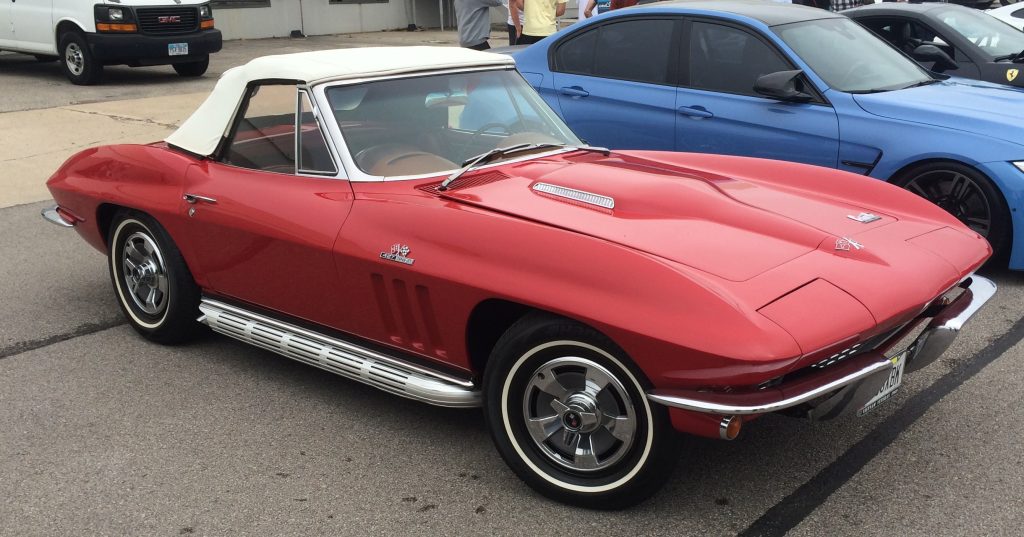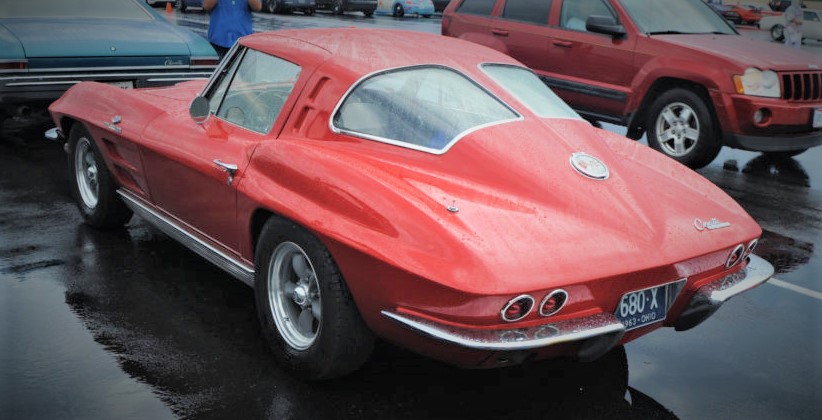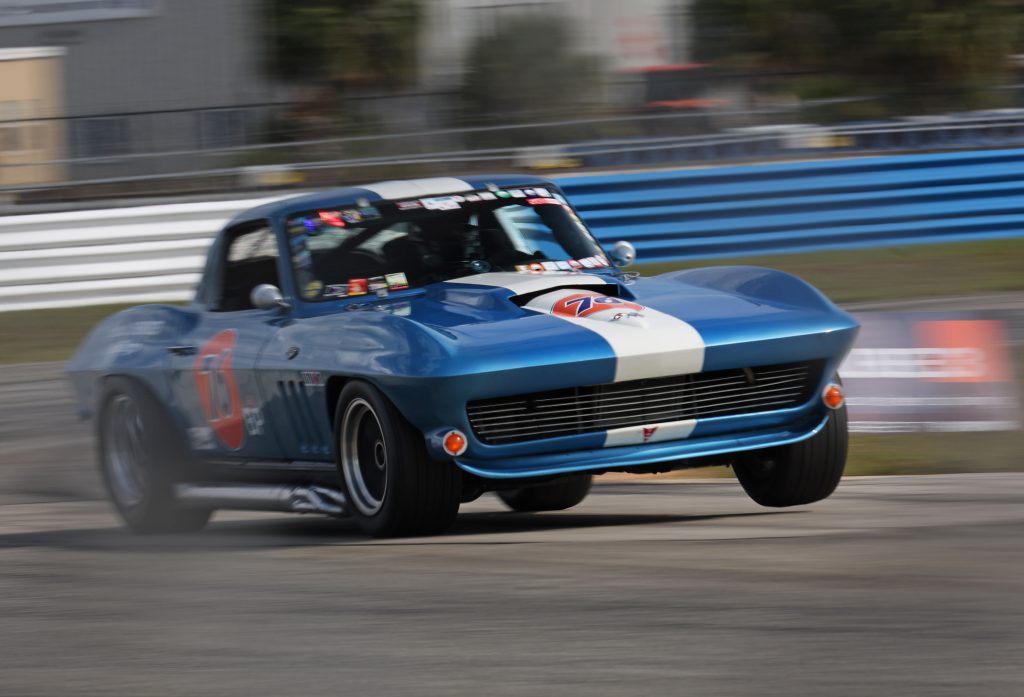
On June 30th, 1953 the first production Corvette rolled off the assembly line.
And after some early growing pains, the Corvette was well on its way to becoming an American icon as the 1960s dawned. So let’s take a look at the Corvette’s C2 Generation—the era that firmly stamped the words Split Window, Big Block, and Sting Ray into the gearhead lexicon.
This article is part of an expanding series on the history of the Corvette. You can see all the stories we have so far here:
- A Look Back at the History of the Corvette C1 (1953-62) Generation
- A Look Back at the History of the Corvette C2 (1963-67) Sting Ray Generation
- A Look Back at the History of the Corvette C3 (1968-82) Stingray Generation
- A Look Back at the History of the Corvette C4 (1984-96) Generation
- A Look Back at the History of the Corvette C5 (1997-2004) Generation
Fishing for New Inspiration
Automotive designer Bill Mitchell was hired by General Motors in the 1930s and quickly rose through the ranks at GM. He was soon tapped as the Chief Designer over in the Cadillac division and eventually became GM’s Director of Styling, right underneath the legendary Harley Earl. And when Earl retired in 1958, Mitchell took charge of all of General Motors’ automotive styling efforts.
In a general sense, Mitchell wanted to break away from the extravagance of the 1950s and its chromed, tail-finned excess. To that end, he encouraged his designers to draw inspiration from the tasteful restraint of famous European marques.

But it was a fateful deep-sea fishing trip that provided the influence for the C2 Corvette.
During the trip, Mitchell caught a shark and was taken by its long, sleek silhouette. He worked closely with a design team that included automotive legends Peter Brock and Larry Shinoda to develop a workable concept.
And what followed was the experimental XP-87 Stingray Racer in 1959.
You’ll probably love this article too: A Conversation with Automotive Icon Peter Brock

The Stingray Racer was built on a retired Corvette SS chassis, and featured a small block Chevy V8 topped with aluminum heads, Rochester fuel injection, and a tidy 11:1 compression ratio.
And it was fast too. Campaigned by “The Flying Dentist” Dr. Dick Thompson in 1960, the Stingray Racer won an SCCA National Championship.
Yet while the Stingray Racer only gave hints to where C2 styling was headed, it heavily influenced the XP-720 project that would become the nascent second-gen Corvette.
What’s in a name? Astute readers may notice that we’ve used both Stingray and Sting Ray in this article. Truth is, for the original Stingray Racer, it was one word. Yet when the 1963 Corvette launched, sales literature and emblems described it as Sting Ray. What’s even more interesting is that, when the C3 redesign was introduced in 1968, the name gradually reverted back to the single word “Stingray.”
A Controversial Styling Choice
When the wild new Sting Ray bowed for 1963, it did so with a distinctive rear spear that bisected the coupe’s back window. It was an aesthetic nod to its namesake, creating a rear profile that mimicked a sting ray—right down to its center spine and descending tail.
It was a striking look to say the least.

Problem was, it obviously hindered rearward visibility. And that drew the ire of one of the original “Fathers” of the Corvette, Chief Engineer Zora Arkus-Duntov. Duntov felt that, if the Corvette was going to compete on racetracks with the world’s best sports cars, that rear window obstruction was an unnecessary handicap.
A fierce battle raged between the engineering and styling teams in 1963 over the fate of that rear window. It got so heated that Mitchell is famously (and perhaps erroneously) quoted as saying that, if the center piece was removed, then “you might as well forget the whole thing!”

Ultimately though, the center bar was ditched in favor of a single rear window in 1964. In the years since, 1963 Corvette coupes have earned the nickname “Split Windows,” and their exclusivity means that they’re often darlings of the high-dollar auction circuits.

C2 Design & Evolution
As remarkable as the C2 Corvette appears on the outside, folks often overlook what’s underneath. In fact, the new 1963 Vette’s chassis was so innovative that it actually formed the basis of the C3 redesign as well, soldiering on for nearly two decades. Among other things, it featured a single, transverse rear leaf spring that allowed the Sting Ray to have an independent rear suspension—a forward thinking move that paid dividends on the road courses across America.
And engine development proceeded at a blistering pace too.

When it launched in 1963, the Corvette carried the 327 cubic inch version of Chevy’s small block, that, when ordered with optional fuel injection, could make up to 360 horsepower. And you could get a three- or four-speed manual, along with the trusty Powerglide automatic. Drum brakes were all around.

In 1964, the Sting Ray lost its hood vents and aforementioned rear window spear outside, and received some relatively minor suspension and interior updates. Power output was bumped on the high performance engines, with the top-dog fuel injected 327 now making closer to 375 horsepower.
Not so “mid” anymore. You’ll often hear C2 Corvettes described as “Mid-Years.” And that’s simply because the moniker came about during the C3 generation in the 1970s. With the C4+ generations still well off the horizon, C2 Corvettes were smack-dab in the middle between the C1 and C3. But even after the C4 arrived, the name stuck. So C2s will likely be “Mid-Years” forever.
But in 1965, things got really interesting. In addition to the arrival of the 396 Big Block (which we’ll get to in a sec), side pipes were now optional. Perhaps more importantly, 1965 was the first year that four-wheel disc brakes became standard. Outside, the earlier side scoops gave way to three large vertical “gills” that hearken back to the Sting Ray’s earliest inspiration.
A year later, the 1966 models came through with some minor exterior modifications, and welcomed a new big block—this time punched out to 427 cubic inches.

C2 Corvette performance reached its peak in 1967, thanks to the legendary L88 (again, we’re getting to that part). Outside, the body was a bit sleeker, losing some emblems and trim, and the large side gills were swapped for a smaller set of louvers.
All told, the C2 lasted just five model years, but that was enough to cement its legacy, thanks to a fusion of stunning exterior style and a bit of underhood magic in the form of…
Enter the Mark IV Big Block
Just like many credit the Small Block Chevy V8 for saving the C1 Corvette, some folks point to the Mark IV Chevy Big Block engine for giving the C2 Corvette its high-performance swagger. And it’s easy to see why.

Introduced in 1965, the gearhead world first met the Mark IV Chevy Big Block in the Corvette, though the engine would soon find its way into other cars in Chevy’s full size and intermediate fleet, including the Chevelle and Impala. Initially displacing 396 cubic inches with a 4.094 inch bore and 3.760 inch stroke, the engine made 425 horsepower in the Corvette’s L78 spec.

For 1966, the 396 engine grew to 427 cubes, thanks to an increased 4.250 inch bore (the 3.760 inch stroke remained). At launch, the 1966 Corvette’s 427 came in two flavors: RPO L36 which cranked out 390 horsepower, and RPO L72 that was good for 425 horsepower.

But Chevy really turned up the Big Block wick in 1967.
While a 435 horsepower L71 appeared to be the top shelf 427 on the options sheet, savvy buyers could also choose a mysterious new L88 which, on paper, “only” made 430 hp. Truth is, those 430 ponies were laughably understated—while GM was mum on an official number, most historians peg L88 horsepower at well over 500.

That’s because the L88 was essentially a race-spec engine, running an aggressive mechanical cam and tight 12.5:1 compression. As a result, the engine demanded high octane fuel—and even came with warning decals reminding you of such. The engine’s rowdy demeanor meant that it was a low-volume seller, making L88-equipped Corvettes extremely rare and desirable today (we’re talking potentially millions of dollars here).
Sting Ray Corvettes Go Racing
Building on a legacy that began with the Stingray Racer, the new Sting Ray Corvette soon became a familiar sight at racetracks all over the world. And it all started with the Z06 option in 1963.

Among other things, checking the Z06 box got you heavy duty suspension parts, better brakes with enhanced cooling, a close-ratio four-speed, and a fuel injected L84 327 making 360 horsepower.
In short, the Z06 was basically a “let’s go racing” starter kit.
One other interesting note on the Z06 was its fuel tank. Initially the Z06 package included a much larger 36.5 gallon fuel tank (replacing the stock 20 gallon one) for folks who were into endurance racing. But the larger tank gradually went from being mandatory to optional on the Z06 trim. Those larger tank-carrying Vettes soon got the nickname “Tankers” and are prized by collectors today.

But the Z06 is only part of the C2 Sting Ray’s racing pedigree—enter the Grand Sport.
Zora Arkus-Duntov took the 1963 Corvette Z06 one step further, swapping its 327 for a 377ci aluminum block (for more performance and added lightness). The plan was to build a fleet of factory race cars to take-on the world’s best, particularly at Le Mans.

But it never came to pass. GM’s company-wide ban on sanctioned racing meant that only a quintet of original Grand Sports could be put together. Undaunted, Arkus-Duntov quietly passed those five Grand Sport chassis onto private race teams, where they were somewhat successful—though the lessons learned from the Grand Sport program helped bring about more Corvette performance options, like the aforementioned L88 427 Big Block.

The C2 Corvette Sting Ray Legacy
To say that there was no “sophomore slump” for the Corvette would be an understatement. In fact, if you compiled a list of folks’ favorite Corvette generations, the C2 is usually welded to the top of the rankings.
The C2’s popularity can probably be attributed to a confluence of a few factors, including style, performance, timing, and production. While style and performance can be subjective, remember that the C2 only lasted from 1963 to 1967, giving it the shortest production run of any Corvette generation—no doubt adding to its mystique.

And it was nestled in an era were performance increases were significant with each passing year, yet the C2 exited before things like safety regulations, emission controls, and fuel economy could impact its design and engineering.
For all those reasons and more, the C2 Corvette is a perennial favorite among the Cross-Flag crowd. And while much of the Corvette community is known for painstaking chalk-mark restorations, there is no shortage of folks who like cutting up fiberglass to create radical custom Sting Rays.

What’s really interesting is that the C2 was actually supposed to end in 1966, but further refinement of the upcoming C3 generation demanded the C2 carry on for another year.
The wait was worth it though, as it not only gave us one more C2 Sting Ray to enjoy, it also made room in the GM fish tank for a C3 “Stingray.”
But that’s a story for another day.

Project Crusty: A 1966 Corvette Sting Ray Restomod
The folks over at Summit Racing have a 1966 Corvette Sting Ray that they’re updating with smart performance parts, with the goal of turning it into a modern canyon carver. Check out the video below for a proper introduction:

Great article
[…] GNX was purchased new by his father-in-law, another gearhead who had owned cars like a C2 Corvette Sting Ray and an AMC Rebel Machine in the […]
[…] the Corvette is still in production, the second generation C2 was discontinued in 1967 after five production years. The model we would like to see make a return is the 1963 Corvette […]
[…] the Corvette is still in production, the second generation C2 was discontinued in 1967 after five production years. The model we would like to see make a return is the 1963 Corvette […]